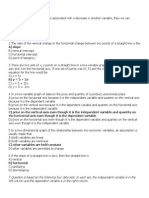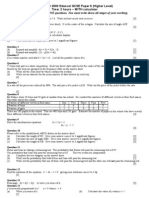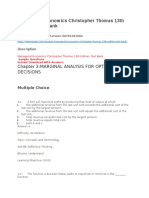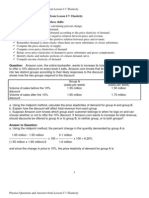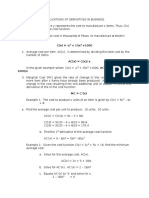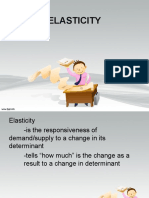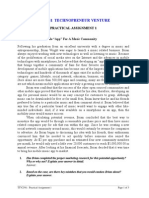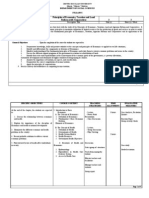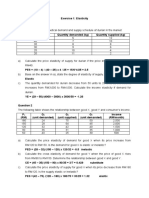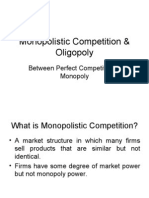Answers To Review Quizzes & Problems - CH 05 PDF
Answers To Review Quizzes & Problems - CH 05 PDF
Uploaded by
Prajna MelittaCopyright:
Available Formats
Answers To Review Quizzes & Problems - CH 05 PDF
Answers To Review Quizzes & Problems - CH 05 PDF
Uploaded by
Prajna MelittaOriginal Title
Copyright
Available Formats
Share this document
Did you find this document useful?
Is this content inappropriate?
Copyright:
Available Formats
Answers To Review Quizzes & Problems - CH 05 PDF
Answers To Review Quizzes & Problems - CH 05 PDF
Uploaded by
Prajna MelittaCopyright:
Available Formats
C h a p t e r
5 EFFICIENCY AND
EQUITY
Answers to the Review Quizzes
Page 109
1. Why do we need methods of allocating scarce resources?
Because resources are scare, it is not possible to fulfill everyones wants. As a result, some method of
deciding which wants will be fulfilled and which will notthat is, some method of allocating
resourcesmust be utilized.
2. Describe the alternative methods of allocating scarce resources.
Resources can be allocated using:
Market price: People who are willing and able to pay the price get the resource.
Command: Someone in command decides who gets the resource.
Majority rule: The majority vote decides how resources are allocated.
Contest: Winners receive the resource.
First-come, first-served: People first in line get the resource.
Lottery: Randomly selected winners receive the resource.
Personal characteristics: People with the right characteristics get the resource.
Force: The stronger person or group gets the resource.
3. Provide an example of each allocation method that illustrates when it works well.
Below are examples of when each allocation scheme works well:
Market price: Generally works well in competitive markets and for most goods and services.
An example is the allocation of cat food.
Command: Generally works well in organizations where lines of authority are clear and it is
easy to monitor subordinates. An example is in a fast food restaurant when the supervisor tells
a worker to clean the tables.
Majority rule: Generally works well when large numbers of people are affected by the
allocation. An example is an election in which people vote whether or not to support a tax to
build more parks.
Contest: Generally works well when the efforts of the participates are hard to monitor. An
example is the contest run by Pfizer in which three top managers competed to see who would
be appointed CEO.
First-come, first-served: Generally works well when a resource can be used by only one user at
a time. An example is a line at a movie ticket booth.
Lottery: Generally works well when there is no way to easily distinguish which user of a
resource would use it most effectively. An example is the lottery used to allocate cell phone
frequencies.
Personal characteristics: Generally works well when resource use is tied between different
people. An example is the decision whom to marry.
Copyright 2010 Pearson Education Canada
74 CHAPTER 5
Force: Generally works well when used to uphold the rule of law. An example is the state
imprisoning thieves.
4. Provide an example of each allocation method that illustrates when it works badly.
Below are examples of when each allocation scheme would work poorly:
Market price: Deciding court cases on the basis of who will pay the most for the decision.
Command: Running an economy.
Majority rule: Deciding how many acres of wheat to plant.
Contest: Allocating food in a winner-take-all contest.
First-come, first-served: Admitting students to college based on who applied first.
Lottery: Assigning grades based on random chance.
Personal characteristics: Renting only to married couples.
Force: Stealing by threat of physical harm.
Page 111
1. How do we measure the value or marginal benefit of a good or service?
The value, or marginal benefit, of a good or service is measured by the maximum amount that
consumers are willing to pay for one more unit of a good or service.
2. What is consumer surplus? How is it measured?
Consumer surplus is the value or marginal benefit of a good minus the price paid, summed over the
quantity of the good purchased. The price per unit of a good is assumed to be equal for all units of the
good purchased. The quantity purchased is determined by equating the marginal benefit to the price
paid. This means that the consumer surplus can be measured as the area under the demand curve and
above the price paid, summed over the entire quantity purchased.
Page 113
1. What is the relationship between the marginal cost, minimum supply-price, and supply?
The minimum supply-price of producing one more unit of a good or service is its marginal cost, and the
marginal cost is the minimum price that producers must receive to induce them to offer one more unit
of a good or service for sale.
2. What is producer surplus? How is it measured?
Producer surplus is the price received for each unit of a good minus the cost of producing it, summed over
all units produced. The price per unit of a good is assumed to be the same for all units of the good sold.
The quantity purchased is that quantity where the marginal cost is equal to the price received. This
means that the producer surplus can be measured as the area under the price and above the supply curve,
summed over the entire quantity sold.
Page 117
1. Do competitive markets use resources efficiently? Explain why or why not.
In the absence of the obstacles mentioned earlier in the chapter, competitive markets use societys
resources efficiently. For resources to be used efficiently they must be allocated to produce the quantity
of a good or service where the marginal cost of the last unit produced in the market is equal to the
marginal benefit. This condition will be met in a competitive market because equilibrium quantity
occurs where the demand curve (which equals the marginal social benefit curve) intersects the supply
curve (which equals the marginal social cost curve).
Copyright 2010 Pearson Education Canada
EFFICIENCY AND EQUITY 75
2. What is deadweight loss and under what conditions does it occur?
The deadweight loss is the is the decrease in total surplus that results from an inefficient level of
production. This is the decrease in consumer surplus plus the decrease in producer surplus that occurs
when the market either overproduces or underproduces relative to the efficient quantity..
3. What are the obstacles to achieving an efficient allocation of resources in the market
economy?
Markets with price or quantity regulations, taxes or subsidies, externalities, public goods or common
resources, monopoly power, or high transactions costs will not produce the efficient quantity of a good
or service. In each of these situations, the market prices charged or quantities produced and sold will not
result in the efficient allocation of resources. Efficiency requires that the marginal social benefit of the
last unit produced be equal to the marginal social cost. The equilibrium at the intersection of the
demand and supply curves in the competitive market creates this result. When the market price or
quantity is pulled away from the market equilibrium, the marginal social benefit of the last unit
produced does not equal its marginal social cost.
Page 121
1. What are the two big approaches to thinking about fairness?
The two big approaches to thinking about fairness are:
Its not fair if the result isnt fair, or utilitarianism.
Its not fair if the rules arent fair, or equality of opportunity.
2. What is the utilitarian idea of fairness and what is wrong with it?
The utilitarian idea of fairness implies that equality of incomes is necessary for the allocation of resources
to be fair. There should be income transfers from the rich to the poor until equality is achieved,
because the marginal benefit of the last dollar of income is the same for everybody. There are two
problem with utilitarianism:
It ignores the cost of implementing the income transfers, which will decrease the total goods and
services that the finite resources of society can produce. The size of the economic pie will be smaller.
It assumes that the existence of decreasing marginal benefits allows us to make inter-personal
comparisons about value gained and lost at different levels of consumption of a good or service.
While one can compare the marginal benefits from consuming different levels of a good or service
for an individual, this is not the same as comparing the marginal benefits from consuming different
levels of a good or service across individuals.
3. Explain the big tradeoff. What idea of fairness has been developed to deal with it?
The big tradeoff is the tradeoff between equality and efficiency. Redistributing incomes changes the
incentives facing producers and consumers. Taxing income decreases producer surplus and taxing
purchases decreases consumer surplus. Producers produce less and consumers consume less, and total
economic activity declines, such that the size of the economic pie decreases. The big tradeoff has led to
the idea that the fairest distribution is that which makes the poorest person as well off as possible.
4. What is the idea of fairness based on fair rules?
The fair rules idea of fairness is that of providing equality of opportunity is necessary for the allocation of
resources to be fair. This is the economic application of the symmetry principle, that people in similar
situations be treated similarly. Equality of opportunity can be achieved if two rules are obeyed:
The government must enforce laws that establish and protect rights to private property that are held
by individuals in society, and
Private property may be transferred from one person to another only by voluntary exchange and
without fraudulent representation.
Copyright 2010 Pearson Education Canada
76 CHAPTER 5
Answers to the Problems and Applications
1. At West, recognized as the jewel of Vancouvers culinary crown, reservations are essential.
At Le Bistro Chez Michel, a restaurant in North Vancouver, reservations are recommended.
At Vijis, a restaurant not far from the University of British Columbia, reservations are not
accepted.
a. Describe the method of allocating scarce table resources at these three restaurants.
All these restaurants use a first-come, first-serve system. Vijis uses this system directly. West uses a first-
come, first-serve because the first person to call to make a reservation at a particular time is allocated the
table at that time. Le Bistro Chez Michel uses a combination of the immediate first-come, first serve
system and the reservation based first-come, first-serve system.
b. Why do you think restaurants have different reservations policies?
The speed with which tables turn over at the different restaurants probably is quite different and the
customers probably have quite different values of time. West has a low turnover rateonly 1 or 2
groups of customers can use a table each nightand its customers have a high value of time. If West
refused to take reservations, its customers would need to wait an inefficiently long time and would go
elsewhere, so Wests profits would fall. At Vijis, the tables have a high turnover rate and the customers
have a lower value of time. Allowing reservations would be costly for Vijis and would spare its
customers only a slight wait at most, so allowing reservations would decrease Vijis profits. At Le Bistro
Chez Michel, the turnover rate of the tables is between that at West and Vijis, so it uses a combination
of phone reservation first-come, first-serve and appear in person first-come, first serve.
c. Why might each restaurant be using an efficient allocation method?
Each restaurant is using a different allocation method because of the relative costs. Each uses the method
that has the lowest cost for the restaurant.
d. Why do you think restaurants dont use the market price to allocate their tables?
Market allocation requires that customers pay for a table and the price would fluctuate from one hour to
the next depending on the number of customers who arrive. Customers would be highly uncertain about
the price they would need to pay and such uncertainty decreases the demand for meals from the
restaurant. The decreased demand lowers the restaurants profit.
2. The table provides
information on the demand Price Quantity demanded
schedules for train travel for (dollars per (kilometre)
Ann, Beth, and Cy, who are kilometre) Ann Beth Cy
the only buyers in the 3 30 25 20
market. 4 25 20 15
5 20 15 10
6 15 10 5
7 10 5 0
8 5 0 0
9 0 0 0
Copyright 2010 Pearson Education Canada
EFFICIENCY AND EQUITY 77
a. Construct the market demand schedule.
The market demand schedule shows the sum of the quantities demanded by Ann, Beth, and Cy at each
price.
Price Quantity demanded
(dollars per (kilometre)
kilometre) Ann Beth Cy Market
3 30 25 20 75
4 25 20 15 60
5 20 15 10 45
6 15 10 5 30
7 10 5 0 15
8 5 0 0 5
9 0 0 0 0
b. What are the maximum prices that Ann, Beth, and Cy are willing to pay to travel 20
kilometres? Why?
Each persons demand schedule shows the maximum price that person is willing to pay to travel 20
kilometres. The maximum price Ann is willing to pay to travel 20 kilometres is $5, the maximum price
Beth is willing to pay is $4, and the maximum price Cy is willing to pay is $3.
c. What is the marginal social benefit when the total distance travelled is 60 kilometres?
The marginal social benefit when the quantity is 60 kilometre is $4 per mile. The marginal social benefit
is determined from the consumers demands and equals the maximum price that consumers will pay for
the quantity. The demand schedule shows that the maximum price consumers will pay for 60 kilometres
is $4 per kilometre and this price equals the marginal social benefit.
d. What is the marginal benefit for each person when they travel a total distance of 60
kilometres and how many kilometres does each of the people travel?
The three travel a total distance of 60 kilometres when the price is $4 a kilometre. Each persons
marginal benefit is $4 per kilometre. At this price Ann travels 25 kilometres, Beth travels 20 kilometres,
and Cy travels 15 kilometres.
e. What is each travelers consumer surplus when the price is $4 a mile?
Anns consumer surplus is $62.50; Beths consumer surplus is $40.00; and, Cys consumer surplus is
$22.50.
When the price is $4 per kilometre, Ann travels 25 kilometres. Anns consumer surplus is the triangular
area under her demand curve and above the price. The demand curve is linear, so Anns consumer
surplus is 1/2 ($9 $4) 25, which equals $62.50.
When the price is $4 per kilometre, Beth travels 20 kilometres. Beths consumer surplus is the triangular
area under her demand curve and above the price. The demand curve is linear, so Beths consumer
surplus is 1/2 ($8 $4) 20, which equals $40.00
When the price is $4 per kilometre, Cy travels 15 kilometres. Cys consumer surplus is the triangular
area under his demand curve and above the price. The demand curve is linear, so Cys consumer surplus
is 1/2 ($7 $4) 15, which equals $22.50.
f. What is the market consumer surplus when the price is $4 a kilometre?
The market consumer surplus is the sum of Anns consumer surplus, Beths consumer surplus, and Cys
consumer surplus, or $125.00.
Copyright 2010 Pearson Education Canada
78 CHAPTER 5
3. eBay Saves Billions for Bidders
If you think you would save money by bidding on eBay auctions, you would likely be right.
... Two associate professors ... calculate the difference between the actual purchase price paid
for auction items and the top price bidders stated they were willing to pay ... and the
Maryland researchers found it averaged at least $4 per auction.
InformationWeek, January 28, 2008
a. What method is used to allocate goods on eBay?
eBay is using market price to allocate the goods. The market price is the price established in the auction.
If someone is willing and able to pay that price, the person will get the item.
b. How do eBay auctions influence consumer surplus?
For the vast majority of auctions, the winning bidder will enjoy a consumer surplus. So eBay increases
consumer surplus. For instance, if there are bidders on a unique item, the winning bidderwho sets the
price for the goodwill pay a price that is equal to the value of the item to the bidder with the second-
highest valuation plus the minimum bid increment. The winning bidder has some consumer surplus as
long as his or her value of the good exceeds the price that must be paid, which will almost always be the
case. Indeed, a person chooses to buy on eBay rather than elsewhere if the person believes that his or her
consumer surplus is largest by purchasing on eBay.
4. The table provides
information on the Price Quantity supplied
supply schedules of hot (dollars (rides per week)
air balloon rides by per ride) Xavier Yasmin Zack
Xavier, Yasmin, and 100 30 25 20
Zack, who are the only 90 25 20 15
sellers in the market. 80 20 15 10
70 15 10 5
60 10 5 0
50 5 0 0
40 0 0 0
a. Construct the market supply schedule.
The market supply schedule shows the sum of the quantities supplied by Xavier, Yasmin, and Zack at
each price.
Price Quantity supplied
(dollars (rides per week)
per ride) Xavier Yasmin Zack Market
100 30 25 20 76
90 25 20 15 60
80 20 15 10 45
70 15 10 5 30
60 10 5 0 15
50 5 0 0 5
40 0 0 0 0
Copyright 2010 Pearson Education Canada
EFFICIENCY AND EQUITY 79
b. What are the minimum prices that Xavier, Yasmin, and Zack are willing to accept to
supply 20 rides? Why?
The minimum supply-price equals the lowest price at which a producer is willing to produce the given
quantity. The supply schedule tells us the minimum supply-price. Xaviers minimum supply-price for 20
rides is $80; Yasmins minimum supply-price is $90; and, Zacks minimum supply-price is $100.
c. What is the marginal social cost when the total number of rides is 30?
The quantity of rides is supplied is 30 when the price is $70 per ride. The marginal social cost of any
quantity is equal to the price for which that quantity will be supplied, so when the total number of rides
is 30, the marginal social cost equals $70 per ride.
d. What is the marginal cost for each supplier when the total number of rides is 30 and how
many rides does each of the firms supply?
When the total number of rides is 30, Xavier supplies 15 rides, Yasmin supplies 10 rides, and Zack
supplies 5 rides. The marginal cost for each firm is $70.
e. What is each firms producer surplus when the price is $70 a ride?
Xaviers producer surplus is $225; Yasmins producer surplus is $100; and, Zacks producer surplus is
$25.
When the price is $70 per ride, Xavier supplies 15 rides. Xaviers producer surplus is the triangular area
under the price and above his supply curve. The supply curve is linear, so Xaviers producer surplus is
1/2 ($70 $40) 15, which equals $225.
When the price is $70 per ride, Yasmin supplies 10 rides. Yasmins producer surplus is the triangular
area under the price and above his supply curve. The supply curve is linear, so Yasmins producer surplus
is 1/2 ($70 $50) 10, which equals $100.
When the price is $70 per ride, Zack supplies 5 rides. Zacks producer surplus is the triangular area
under the price and above his supply curve. The supply curve is linear, so Zacks producer surplus is 1/2
($70 $60) 5, which equals $25.
f. What is the market producer surplus when the price is $70 a ride?
The market producer surplus is equal to the sum of Xaviers producer surplus plus Yasmins producer
surplus plus Zacks producer surplus, which is $225 + $100 + $25 or $350.
5. Based on the information provided in the news clip in problem 3,
a. Can an eBay auction give the seller a surplus?
Yes, an eBay auction can give a seller a surplus. The seller has a minimum supply price for which the
item will be sold. If the price established in the auction exceeds that minimum supply price, the seller
has a surplus.
b. Draw a graph to illustrate an eBay auction
and show the consumer surplus and
producer surplus that it generates.
Figure 5.1 illustrates an eBay auction. The figure
assumes that there are many suppliers of this
good, each with a different minimum supply price
so that the supply curve is upward sloping. The
consumer surplus is area A, the area under the
demand curve and above the (auction-
determined) market price. The producer surplus is
area B, the area under the market price and above
the supply curve.
Copyright 2010 Pearson Education Canada
80 CHAPTER 5
6. The figure illustrates the market for cell
phones.
a. What are the equilibrium price and
equilibrium quantity of cell phones?
The equilibrium price is $30 per cell phone and
the equilibrium quantity is 100 cell phones per
month.
b. Shade in and label the consumer surplus and
the producer surplus.
In Figure 5.3 (on the next page) the consumer
surplus is the shaded area A and the producer
surplus is the shaded area B.
c. Shade in and label the cost of producing the
cell phones sold.
In Figure 5.3 (on the next page) the cost of
producing the cell phones sold is equal to area C.
d. Calculate total surplus.
The total surplus is equal to the sum of the
consumer surplus plus the producer surplus, or
the triangle with area A + area B. The amount of
the total surplus equals ($60 per cell phone
$15 per cell phone) 100 cell phones, which is
$2,250.
e. What is the efficient quantity of cell
phones?
The efficient quantity of cell phones is 100 cell
phones per month.
Copyright 2010 Pearson Education Canada
EFFICIENCY AND EQUITY 81
7. The table gives the demand and supply
schedules for sunscreen. Sunscreen Quantity Quantity
factories are required to limit Price demanded supplied
production to 100 bottles a day. (dollars per bottle) (bottles per day)
0 400 0
5 300 100
a. What is the maximum price that
10 200 200
consumers are willing to pay for the
15 100 300
100th bottle?
20 0 400
Consumers are willing to pay a
maximum price of $15 for the 100th bottle of sunscreen. The demand schedule shows the maximum
price that consumers will pay for each bottle of sunscreen. The maximum price that consumers will pay
for the 100th bottle is $15.
b. What is the minimum price that producers are willing to accept for the 100th bottle?
Producers are willing to accept a minimum price of $5 for the 100th bottle of sunscreen. The supply
schedule shows the minimum price that producers will accept for each bottle of sunscreen. The
minimum price that produces will accept for the 100th bottle is $5.
c. Describe the situation in this market.
There is less than the efficient quantity being produced. The efficient quantity is the equilibrium
quantity, 200 bottles.
d. How can the 100 bottles be allocated to beachgoers? Which possible methods would be fair
and which would be unfair?
The bottles can be allocated using a contest (a raffle for the bottles, perhaps), first-come, first-served (a
line until all 100 bottles are distributed), personal characteristics (perhaps all fair-haired people are
allocated the sun screen), or force (a fight). Using the fair results criteria, none of the allocation
schemes are necessarily fair because there is no guarantee that poorer people will receive the sun screen.
Using the fair rules criteria, the force method is definitely unfair and the others are fair.
8. Wii Sells Out Across Japan
Japan finally came in for its share of Wii madness this weekend. However, given the
large amount of interest in the consolewhich Nintendo has flogged with a TV-ad blitz for
the past two monthsdemand is expected to be much higher than supply. Yodobashi
Camera was selling Wii games on a first-come, first-served basis, so eager customers showed
up early so as not to miss out on their favorite titles. [But] customers who tried to get in the
line after 6 or 7 a.m. were turned away. [and] many could be spotted rushing off to
the smaller Akihabara stores that were holding raffles to decide who got a Wii.
Gamespot News, Dec 1, 2006
a. Why was the quantity demanded of Wii expected to exceed the quantity supplied?
At the price of a Wii set by Nintendo, the quantity demanded was forecast to exceed the quantity
supplied. Stores could run surveys to determine how many customers were likely to buy a Wii from the
store. The survey could be as informal as clerks reporting how many people asked about a Wii during
the clerks shift to more formal by asking customers to sign up in advance to buy a Wii. Given these
surveys, the quantity demanded was expected to exceed the quantity Nintendo released for sale.
b. Did Nintendo produce the efficient quantity of Wii? Explain
At the price Nintendo set, Nintendo did not produce the efficient quantity of Wii. There was a shortage
of Wii consoles. The MSB of a Wii exceeds the MSC so the market is inefficient.
Copyright 2010 Pearson Education Canada
82 CHAPTER 5
c. Can you think of reasons why Nintendo might want to underproduce and leave the market
with fewer Wii than people want to buy?
Nintendo might have wanted to create a shortage to gain more publicity for its Wii. If news reporters
had story after story about the shortage, then Nintendo would gain free publicity. Additionally, given
the very high initial demand for a Wii, if the price was set so that the quantity supplied equaled the
initial (very high) quantity demanded, then the price would be high. After the initial adopters were
satisfied, the price would then fall and Nintendo would get a reputation for price gouging.
d. What are the two methods of resource allocation described in the news clip?
The first store was using a first-come, first serve method of allocation. The second, smaller stores were
allocating Wii using a lottery so that winners would obtain a Wii.
e. Is either method of allocating Wii efficient?
Neither method is likely efficient. But given that the price was not going to charge to allocate the Wii,
some other method or methods had to be used to allocate the Wii.
f. What do you think some of the people who managed to buy a Wii did with it?
Some of the people who acquired a Wii resold it to other people.
g. Explain which is the fairer method of allocating the Wii: the market price or the two
methods described in the news clip.
Allocating Wii according to the market price is not necessarily fair using the fair results approach but
is fair using the fair rules approach. The other two methods of allocation are fair according to either of
fairness measures only by random chance.
9. New Zealands Private Forests
In the late 1980s, New Zealand decided it was time to quit cold turkey. Its addiction was
government. By the early 1990s, New Zealand had [sold] half of the countrys total
plantation forests to the highest bidder, introducing an era of privately-owned forests. We
want [timber companies] to behave like farmers. Farmers make sure they dont destroy the
soil or run down its fertility. Farmers look after their farms to make them continuously
productive. The argument right from the start was [i]ts a commercial decision. These
are supposedly commercial forests planted to make a profit.
Reuters, September 7, 2007
a. In the late 1980s, was the New Zealand timber industry efficient? Did logging companies
operate in the social interest or self-interest?
In the late 1980s, the logging companies were operating in their self-interest. They were producing
more than the efficient quantity. Marginal cost exceeded marginal benefit. The logging companies were
not considering all of the costs of production because they did not own the land on which they were
working. They had no incentive to preserve forestland or to cut timber in a way that would make
future harvesting of trees profitable.
b. Since the early 1990s, has the New Zealand timber industry been efficient? Have logging
companies operated in the social interest or self-interest?
Since the early 1990s, the logging companies have been operating in the self-interest and the social
interest. They are producing the efficient quantity. Marginal social cost equals marginal social benefit
because the private forest owners charge the logging companies for the use of the land.
The logging companies now must consider all of the costs of producing.
c. What incentive do private timber companies have to ensure that they operate like
farmers?
The incentive that private companies have to ensure that they "operate like farmers" is profit.
If loggers deplete the forests this year, they will have no profit in the years to come. The private timber
company has the incentive to maximize its profit over the long term. This incentive means that the
Copyright 2010 Pearson Education Canada
EFFICIENCY AND EQUITY 83
timber company will preserve the efficient quantity of young trees and allow them to grow to maturity,
and will plant new trees to have trees to harvest in the future.
10. The table gives the supply
Price Quantity supplied
schedules for jet-ski rides by
(dollars (rides per week)
three owners: Rick, Sam, and
per ride) Rick Sam Tom
Tom, the only suppliers of jet-
ski rides. 10.00 0 0 0
12.50 5 0 0
15.00 10 5 0
a. What is each owners 17.50 15 10 5
minimum supply-price of 10 20.00 20 15 10
rides a day?
Ricks minimum supply- price for 10 rides is $15.00, Sams minimum supply-price is $17.50, and
Toms minimum supply-price is $20.00.
b. Which owner has the largest producer surplus when the price of a ride is $17.50? Explain.
Rick has the largest producer surplus when the price is $17.50. Ricks producer surplus is largest because
he produces the largest quantity and his costs are lower than those of the other producers. More
formally, each suppliers producer surplus is equal to the area under the price and above that producers
supply curve. Calculating these areas of producer surplus, Ricks producer surplus is $56.25, Sams
producer surplus is $25.00, and Toms producer surplus is $6.25.
c. What is the marginal social cost of producing 45 rides a day?
45 rides are produced when the price is $20.00, so the marginal social cost of producing 45 rides a day is
$20.00.
d. Construct the market supply schedule of jet-ski rides.
When the price is $10.00, the quantity of rides supplied is 0; when the price is $12.50, the quantity
supplied is 5 rides; when the price is $15.00, the quantity supplied is 15; when the price is $17.50, the
quantity supplied is 30; and, when the price is $20, the quantity supplied is 45.
11. The table gives the demand and
supply schedules for sandwiches. Quantity Quantity
Price demanded supplied
a. What is the maximum price that (dollars per sandwich) (sandwiches per hour)
consumers are willing to pay for
0 300 0
the 200th sandwich?
1 250 50
The demand schedule shows the
2 200 100
maximum price that consumers will
3 150 150
pay for each sandwich. The maximum
4 100 200
price consumers will pay for the 200th
sandwich is $2.
5 50 250
6 0 300
b. What is the minimum price that
producers are willing to accept for the 200th sandwich?
The supply schedule shows the minimum price that producers will accept for each sandwich. The
minimum price for which produces will produce the 200th sandwich is $4.
c. Are 200 sandwiches a day less than or greater than the efficient quantity?
200 sandwiches a day are more than the efficient quantity because the marginal social benefit (the
maximum price consumers will pay) is less than the marginal social cost (the minimum price suppliers
will accept).
Copyright 2010 Pearson Education Canada
84 CHAPTER 5
d. If sandwich makers produce 200 a day, what is the deadweight loss?
The deadweight loss is $50. Deadweight loss is the sum of the consumer surplus and producer surplus
that is lost because the quantity produced is not the efficient quantity. The deadweight loss equals the
quantity (200 150) multiplied by ($4 $2)/2, which is $50.
e. If the sandwich market is efficient, what is the consumer surplus, what is the producer
surplus, and what is the total surplus?
150 sandwiches is the efficient quantity and the equilibrium price is $3. The consumer surplus is the
area of the triangle under the demand curve above the price. The area of the consumer surplus triangle is
($6 $3) 150, which is $225. The producer surplus is the area of the triangle above the supply
curve below the price. The price is $3 and the quantity is 150. The area of the triangle is 1.2 ($3
$0) 150, which is $225. The total surplus is the sum of the consumer surplus plus the producer
surplus, which is $450.
f. If the demand for sandwiches increases and sandwich makers produce the efficient
quantity, what happens to consumer surplus and producer surplus?
If the demand for sandwiches increases, the price and quantity of sandwiches both rise. The producer
surplus definitely increases. The effect on consumer surplus is ambiguous. It rises if the quantity
increases by a larger percentage than does the price but it falls if the price rises by a larger percentage
than does the quantity.
12. The Right Price for Digital Music: Why 99 Cents per Song is Too Much, and Too Little.
Apples 99-cents-for-everything model isnt perfect. Isnt 99 cents too much to pay for music
that appeals to just a few people? What we need is a system that will continue to pack the
corporate coffers yet be fair to music lovers. The solution: a real-time commodities market
that combines aspects of Apples iTunes, Nasdaq, the Chicago Mercantile Exchange,
Priceline, and eBay. ... Songs would be priced strictly on demand. The more people who
download [a particular song] ... the higher the price [of that song] will go. ... The fewer
people who buy a [particular] song, the lower the price [of that song] goes. ... In essence,
this is a pure free-market solutionthe market alone would determine price.
Slate, December 5, 2005
Assume that the marginal social cost of downloading a song from the iTunes store is zero.
(This assumption means that the cost of operating the iTunes store doesnt change if people
download more songs.)
a. Draw a graph of the market for downloadable music with a price of 99 cents for
everything. On your graph, show consumer surplus and producer surplus.
Figure 5.4 shows this market. The marginal social
cost curve runs along the horizontal axis. The
consumer surplus is area A and the producer
surplus is area B.
b. With a price of 99 cents for everything, is
the market efficient or inefficient? If it is
inefficient, show the deadweight loss on
your graph.
The market is inefficient. Efficiency requires that
the amount be the quantity for which the
marginal social benefit equals the marginal social
cost, which in this case is the quantity at which
the marginal social benefit curve intersects the
Copyright 2010 Pearson Education Canada
EFFICIENCY AND EQUITY 85
horizontal axis. The deadweight loss is area C in Figure 5.4.
c. If the pricing scheme described in the news clip were adopted, how would consumer
surplus, producer surplus, and the deadweight loss change?
The price of popular songs rises, so the consumer surplus for popular songs decreases and the producer
surplus increases. A larger deadweight loss is created. The price of unpopular songs falls, so the consumer
surplus for unpopular songs increases and the producer surplus decreases. A smaller deadweight loss is
created.
d. If the pricing scheme described in the news clip were adopted would the market be
efficient or inefficient? Explain.
The market would likely become more inefficient because the inefficiency of the popular songsthe
songs most people wantincreases. The price exceeds the marginal social cost.
e. Is the pricing scheme described in the news clip a pure free-market solution? Explain.
With a pure free-market solution the price is determined by supply and demand. The pricing method
discussed in the clip uses only demand and so it is not the same as a pure free-market solution. A pure
free market solution produces the efficient quantity of 200 downloads and the price is zero.
13. A winter storm cuts the power supply and isolates a small town in the mountains. The
people rush to buy candles from the town store, which is the only source of candles. The
store owner decides to ration the candles to one per family but to keep the price of a candle
unchanged.
a. Who gets to use the candles? Who receives the consumer surplus and who receives the
producer surplus on candles?
The people who buy candles from the town store are not necessarily the people who use the candles. A
buyer from the town store can sell a candle and will do so if he or she can get a price that exceeds his or
her marginal benefit. The people who value the candles mostwho are willing to pay the mostwill
use the candles.
Only the people who are willing to pay the most for candles receive the consumer surplus on candles,
and the store owner receives the same producer surplus as normal. People who sell the candles they buy
from the store receive additional producer surplus.
b. Is the allocation efficient? Is the allocation fair?
The allocation is efficient because the people who value the candles most use them. Two views of
fairness: The rules view is that if the rule of one candle per family is followed and exchange is voluntary,
then the outcome is fair. But the results view is that if the candles are allocated unequally, then the
allocation is unfair.
14. Ticketmaster Accused of Price-Gouging in Canada
As if the imminent Live Nation ticketing venture wasnt enough for Ticketmaster, the
company now has to deal with accusations of price gouging by angry Elton John fans in
Saskatchewan. When tickets for Elton Johns performance in the capital city of Saskatoon
went on sale, fans discovered that Ticketmaster had already sold out of their allotment, and
instead recommended fans try to buy tickets at Tickets Now, a secondary ticketing site
owned by Ticketmaster. Not only did Tickets Now already have tickets for sale, but they
were also demanding much higher prices than originally posted on Ticketmaster, leading
fans to accuse the company of scalping. ... Ticketmaster said they were not aware they were
shuffling fans to Tickets Now and has since removed the link. The companys head of
ticketing in Saskatchewan said, The inventory belongs to the promoter and artist, and the
artist determines who has what privileges in advance of the public on sale or not, like fan
clubs for instance.
Rolling Stone, July 14, 2008
Copyright 2010 Pearson Education Canada
86 CHAPTER 5
a. What is price-gouging? Is price gouging in the social interest or self-interest?
"Price gouging" is a term used to describe a situation in which a seller sells a good at a price that is
higher than what is considered reasonable or fair. In common usage, "price gouging" also refers to
prices that are set by practices inconsistent with a competitive market.
Choices made in self-interest are the choices that you think are the best ones available for you. Choices
in the social interest are choices that are the best ones for society as a whole. If the higher price arises
because of an increase in demand or a decrease in supply or a combination of both, then the higher price
is the equilibrium price, the market is efficient, and the higher price is in the social interest. Total
surplus is maximized.The higher price is also in the self-interest of Ticketmaster. It is setting the
price to maximize profit.
b. Explain the effect of the companys scalping on consumer surplus and producer surplus.
A person who buys a ticket from a scalper and attends the concert receives a smaller consumer surplus
than he or she would have received if he or she had paid the original price for the ticket. The scalper sells
the ticket for more than he paid for it, so he receives a producer surplus. The scalper converts some
consumer surplus to producer surplus. Total surplus, the sum of consumer surplus and producer surplus,
does not change. So scalping reduces the consumer surplus and increases the producer surplus but
does not change total surplus.
c. Evaluation the fairness of Ticketmaster shuffling fans to Tickets Now when the
concert tickets went on sale to the public.
Ticketmaster's actions were unfair by the fair results view because the tickets did not necessarily go to the
poorest people. The tickets went to the richer people who could afford the higher priced tickets on sale
at Tickets Now. Ticketmaster' actions were fair by the fair rules view because the ticket transactions
involved voluntary exchange.
d. Describe the allocation method used when the artist determines who has what privileges
in advance of the public on sale or not, like fan clubs for instance.
A command system allocates resources by the order (command) of someone in authority. When "the
artist determines who has what privileges in advance of the public on sale or not, like fan clubs for
instance", the artist orders or commands who will get the tickets.
15. Fight Over Water Rates; Escondido Farmers Say Increase Would Put Them Out of Business
The city is considering significant increases in water rates for agriculture, which historically
has paid less than residential and business users. . . . [S]ince 1993, water rates have gone up
more than 90 percent for residential customers while agricultural users. . .have seen
increases of only about 50 percent, . . .
The San Diego Union-Tribune, June 14, 2006
a. Do you think that the allocation of water among San Diego agricultural and residential
users is likely to be efficient? Explain your answer.
The allocation of water is almost surely inefficient. If the marginal social cost curve of distributing water
is the same for agricultural and residential users, as is probably the case, the only way that the allocation
scheme can be efficient is if the marginal social benefit curve of agricultural lies below the marginal
social benefit curve of residential users. Such a situation seems unlikely because water is necessary for
agricultural users to grow their crops so the marginal social benefit of water to farmers probably exceeds
that for residential users.
b. If agricultural users pay a higher price for water, will the allocation of resources become
more efficient?
If agricultural users pay a higher rate for water, probably the allocation of resources will be more
efficient. Efficiency requires that marginal social benefit equals marginal social cost. Currently it is likely
the case that the marginal social benefit of the last unit of water for agricultural users is less than the
marginal social cost of producing the last unit of water.
Copyright 2010 Pearson Education Canada
EFFICIENCY AND EQUITY 87
c. If agricultural users pay a higher price for water, what will happen to consumer surplus
and producer surplus from water?
If the price paid by agricultural users rises, the consumer surplus of agricultural users decreases and the
producer surplus increases.
d. Is the difference in price paid by agricultural and residential users fair?
According to the fair results approach, the difference in price is fair only if agricultural users are poorer
than residential users. If, however, agricultural users are wealthier than or comparable to residential
users, the difference in price is not fair. The difference in price is not fair according to the fair rules
approach because the price of water is not determined in competitive markets.
15. After you have studied Reading Between the Lines on pp. 122123, answer the following
questions:
a. What is the major problem in achieving an efficient use of the worlds water?
Water needs to be transported from where it is available to where it is needed. This basic issue leads to
two major problems: Overproduction in some areas and underproduction in other areas. Often
overproduction in an area leads to underproduction later in the same area. In particular, markets in
water are not competitive. In many areas, water is free to whomever digs a deep enough well. As a
result, too many people dig wells and water is overproduced. If the overproduction is bad enough, the
level of groundwater can be reduced so far that it becomes literally impossible to extract any water. Then
water needs to be transported to the now arid area. In this case, often the government transports the
water and sells it at a very low price or gives it away. But because the government does not sell the water
at an equilibrium price (and because the government is not motivated by seeking profit) less water is
transported than the efficient quantity.
b. If there were a global market in water, like there is in oil, how do you think the market
would work?
The market for water would be more efficient than the current situation. Areas with a great deal of
water, say Canada, could export water to areas with less water, say Mexico. If water was purchased and
sold in markets, there would be greater incentive to build desalination plants where they are practical as
well as greater incentive to conserve water where it is in abundance.
c. Would a free world market in water achieve an efficient use of the worlds water resources?
Explain why or why not.
A free world market in water likely would (eventually) bring an efficient use of resources as the necessary
infrastructure was constructed. Of the factors that can lead to inefficiency (government price and
quantity regulations, monopoly power, and so forth) the only issue that could possibly lead to
inefficiency is the point that water is a common resource in some situations.
d. Would a free world market in water achieve a fair use of the worlds water resources?
Explain why or why not and be clear about the concept of fairness that you are using.
A fair results approach to fairness would argue that in third world countries, very poor inhabitants (for
example, nomads) would not be able to afford enough water and so some redistribution is needed for
the sake of fairness. A fair rules approach to fairness asserts that a competitive market is enough to
insure fairness.
Copyright 2010 Pearson Education Canada
88 CHAPTER 5
17. Use the link on MyEconLab (Chapter Resources, Chapter 5, Web links) to visit the Web site
of Health Action International and read the article by Catrin Schulte-Hillen entitled Study
concerning the availability and price of AZT. Then answer the following questions and
explain your answers using the concepts of marginal benefit, marginal cost, price, consumer
surplus, and producer surplus.
a. What is the range of retail prices of AZT across the countries covered by the study?
The retail (pharmacy) prices range from $0.67 in Thailand to $2.80 in Germany.
b. What, if anything, do you think could be done to increase the quantity of AZT and decrease
its price?
The article states that The major determining factor is the existence of alternative products on the
market, i.e. competition. So one factor that will lead to lower prices and increased quantities is either
disregard the patent or wait until the patent expires. In either case, the increased competition will lead to
lower prices and increased quantities. If the government does not want to disregard the patent, it could
try to negotiate lower prices by perhaps arranging purchases of larger quantities. Or the government
could simply lower the allowable legal price for AZT in the nation. The drawback with this last policy is
that it might lead to a decrease in the quantity of AZT available.
c. Canadian online pharmacies sell AZT to Americans for a price below the U.S. price. Does
this practice increase or decrease consumer surplus, producer surplus, and deadweight loss
from AZT in the United States?
The practice of Canadian on-line pharmacies selling AZT in the United States at a price below the U.S.
price increases consumer surplus in the United States. U.S. producers sell AZT to Canadian pharmacies,
but at a lower price than they can sell the drug in the United States. To the extent that the Canadian
sales replace sales of U.S.-sold products, producer surplus in the Untied States decreases. However, to
the extent that the product is manufactured in the United States and to the extent that these sales are
new, that is, would not have been made except for the lower price, the sales increase U.S. producer
surplus. Producer surplus in Canada increases.
Copyright 2010 Pearson Education Canada
You might also like
- Macroeconomics Canada in The Global Environment Canadian 9th Edition Parkin Solutions Manual 1Document22 pagesMacroeconomics Canada in The Global Environment Canadian 9th Edition Parkin Solutions Manual 1richard100% (69)
- Econ AssignmentDocument6 pagesEcon Assignmentali ahmed100% (2)
- 1.1.1 Determinants of Demand ANSWER KEYDocument4 pages1.1.1 Determinants of Demand ANSWER KEYpaulwilson420No ratings yet
- Possibilites, Preferences, and Choices: Answers To The Review QuizzesDocument16 pagesPossibilites, Preferences, and Choices: Answers To The Review QuizzesWeko CheangNo ratings yet
- ECON: Practice Quizes 1-5Document37 pagesECON: Practice Quizes 1-5Audrey JacksonNo ratings yet
- Personnel Economics-Answers Exercise 1Document9 pagesPersonnel Economics-Answers Exercise 1Mhykl Nieves-Huxley67% (3)
- CA5102 - Managerial Economics-3 PDFDocument20 pagesCA5102 - Managerial Economics-3 PDFBlack ScoopNo ratings yet
- Exam#1 (1) SolutionDocument6 pagesExam#1 (1) SolutionaininhusninaNo ratings yet
- Case Study 1 Demand and Supply of Wii Console Questions and DiscussionsDocument29 pagesCase Study 1 Demand and Supply of Wii Console Questions and DiscussionsVisitacion Sunshine Baradi100% (1)
- Edexcel Nov 2000 Paper 6Document2 pagesEdexcel Nov 2000 Paper 6Varun PanickerNo ratings yet
- Suggested Homework AnsDocument6 pagesSuggested Homework AnsFeric KhongNo ratings yet
- Practice Multiple Choice1Document11 pagesPractice Multiple Choice1rajman22No ratings yet
- Crafting A Livelihood - DasraDocument37 pagesCrafting A Livelihood - Dasraswatijoshi_niam08No ratings yet
- Financials of PAFDocument26 pagesFinancials of PAFAbhishek PandaNo ratings yet
- Indifference Curve Analysis and Demand CurveDocument4 pagesIndifference Curve Analysis and Demand Curvesujeet_kumar_nandan798483% (6)
- Managerial Economics Christopher Thomas 13th Edition-Test BankDocument85 pagesManagerial Economics Christopher Thomas 13th Edition-Test BankPatil YacoubianNo ratings yet
- Micro Assignment 2 - Utility, Consumer SurplusDocument5 pagesMicro Assignment 2 - Utility, Consumer SurplusDarlene HarrisNo ratings yet
- Ch. 2 Consumer BehaviorDocument7 pagesCh. 2 Consumer BehaviorJeegar BhattNo ratings yet
- Application of Differentiation To EconomicsDocument6 pagesApplication of Differentiation To Economicsvaibhavarora273No ratings yet
- Activity 3: Colegio de La Purisima Concepcion The School of The Archdiocese of Capiz Roxas CityDocument2 pagesActivity 3: Colegio de La Purisima Concepcion The School of The Archdiocese of Capiz Roxas CityAte GandaNo ratings yet
- Elasticity Practice TestDocument8 pagesElasticity Practice TestAmir NelsonNo ratings yet
- Test Development Economics by Yasir KarimDocument14 pagesTest Development Economics by Yasir KarimShabana ShboNo ratings yet
- CH 04Document40 pagesCH 04Mohammed Aljabri100% (1)
- Demand ElasticityDocument21 pagesDemand ElasticityzozoadilNo ratings yet
- Assignment - 2 With Answer-1Document7 pagesAssignment - 2 With Answer-1rawan ANo ratings yet
- Marginal Rate of Technical SubstitutionDocument9 pagesMarginal Rate of Technical Substitutionbhaktikhanna87No ratings yet
- OligopolyDocument32 pagesOligopolyAnj SelardaNo ratings yet
- Practice Questions - Monopoly - AnswersDocument12 pagesPractice Questions - Monopoly - AnswersHazel Jean DeteralaNo ratings yet
- Cost FunctionDocument19 pagesCost FunctionSanam KhanNo ratings yet
- Microeconomics - Econ - 101 PDFDocument164 pagesMicroeconomics - Econ - 101 PDFSatis ChaudharyNo ratings yet
- Microeconomics Assignment 8Document17 pagesMicroeconomics Assignment 8abreaNo ratings yet
- Labor Economics: Chapter-05 Compensating Wage DifferentialsDocument42 pagesLabor Economics: Chapter-05 Compensating Wage DifferentialsIqbal ChyNo ratings yet
- Module-8 Break Even AnalysisDocument17 pagesModule-8 Break Even AnalysisDrKanchan GhodkeNo ratings yet
- Chapter 5 Module in Managerial EconomicsDocument8 pagesChapter 5 Module in Managerial EconomicsOne DozenNo ratings yet
- Chapter 8Document5 pagesChapter 8clara2300181No ratings yet
- Unit 1. Quality, Total Quality, TQMDocument29 pagesUnit 1. Quality, Total Quality, TQMsbmallur100% (2)
- Econ 03 Nvsu FR Icd 05 00Document15 pagesEcon 03 Nvsu FR Icd 05 00Kristian Allen B. DomingoNo ratings yet
- Chapter 14 - Firms in Competitive MarketsDocument32 pagesChapter 14 - Firms in Competitive MarketsĐại Hà ChâuNo ratings yet
- Consumer Behavior and Rational Choice: Managerial EconomicsDocument62 pagesConsumer Behavior and Rational Choice: Managerial EconomicsalauoniNo ratings yet
- 10 Principles of Economics - WikiversityDocument24 pages10 Principles of Economics - WikiversityprudenceNo ratings yet
- Set 6 AnswersDocument11 pagesSet 6 AnswersidentifierNo ratings yet
- Job-Order Costing: Cost Flows and External ReportingDocument57 pagesJob-Order Costing: Cost Flows and External ReportingGigo Kafare BinoNo ratings yet
- Production Analysis PPT at BEC DOMSDocument26 pagesProduction Analysis PPT at BEC DOMSBabasab Patil (Karrisatte)No ratings yet
- Applications of Derivatives in Business and EconomicsDocument6 pagesApplications of Derivatives in Business and EconomicsTed Bryan D. Cabagua100% (1)
- Michael Parkin: Output and CostsDocument42 pagesMichael Parkin: Output and CostsTooba NoushadNo ratings yet
- Economics Fresh Final ExamDocument5 pagesEconomics Fresh Final ExamTerefe Bergene bussa100% (1)
- Production Cost Questions With AnswersDocument2 pagesProduction Cost Questions With AnswersHamza Mohamed50% (2)
- EAB Numerical Elasticity of DemandDocument10 pagesEAB Numerical Elasticity of DemandReeha NeupaneNo ratings yet
- Chapter 1 Statistics: Case Study 1.1Document5 pagesChapter 1 Statistics: Case Study 1.1kxholli03No ratings yet
- Price Discrimination Under Monopoly: Types, Degrees and Other DetailsDocument18 pagesPrice Discrimination Under Monopoly: Types, Degrees and Other DetailsSanchit BabbarNo ratings yet
- Solved ProblemsDocument8 pagesSolved Problemsantony1993No ratings yet
- Theory of Consumer BehaviorDocument27 pagesTheory of Consumer BehaviorchandruNo ratings yet
- Assignment 2 Demand & Supply PDFDocument6 pagesAssignment 2 Demand & Supply PDFhemantNo ratings yet
- Exam#1 (1) SolutionDocument5 pagesExam#1 (1) Solutiondiger100% (1)
- What Is Market EquilibriumDocument2 pagesWhat Is Market EquilibriumNormashita Che DinNo ratings yet
- Elasticity of DemandDocument38 pagesElasticity of DemandimadNo ratings yet
- Review Session 1 EconS301 Fall2010Document6 pagesReview Session 1 EconS301 Fall2010marko2606100% (1)
- DepreciationDocument30 pagesDepreciationjosua siregarNo ratings yet
- Demand Supply and Markets Keat and Young - 2Document96 pagesDemand Supply and Markets Keat and Young - 2Dhruv SoodNo ratings yet
- Latian CH 5Document17 pagesLatian CH 5kezia yulinaNo ratings yet
- SM Econ 05 Micro Ch05Document24 pagesSM Econ 05 Micro Ch05senrucatNo ratings yet
- Macroeconomics Canada in The Global Environment Canadian 9th Edition Parkin Solutions Manual 1Document36 pagesMacroeconomics Canada in The Global Environment Canadian 9th Edition Parkin Solutions Manual 1tinacunninghamadtcegyrxz100% (46)
- Week 06 2022 Topic 6 Lecture Financial Instruments Part CDocument26 pagesWeek 06 2022 Topic 6 Lecture Financial Instruments Part CErnest LeongNo ratings yet
- Homework Answers 1Document3 pagesHomework Answers 1Vel NefertariNo ratings yet
- Chapter3 Elasticity and ForecastingDocument25 pagesChapter3 Elasticity and ForecastingGee JoeNo ratings yet
- Industrial Marketing Unit 1Document10 pagesIndustrial Marketing Unit 1scribdranijNo ratings yet
- Partnership Formation QuizDocument1 pagePartnership Formation QuizMaria Carmela MoraudaNo ratings yet
- 2nd Quiz Key To CorrectionDocument3 pages2nd Quiz Key To CorrectionJohn Paul MagbitangNo ratings yet
- Recommended Price Control For SFG and FGDocument2 pagesRecommended Price Control For SFG and FGSenthilNathanNo ratings yet
- Market IntegrationDocument4 pagesMarket IntegrationOrlando UmaliNo ratings yet
- Accountancy Chap 3 Theory NotesDocument17 pagesAccountancy Chap 3 Theory NotesRevati MenghaniNo ratings yet
- Epicor10 FeatureSummary 101600Document143 pagesEpicor10 FeatureSummary 101600Andrie ObedencioNo ratings yet
- Moats Part OneDocument9 pagesMoats Part OnerobintanwhNo ratings yet
- CBSE Class 8 Mathematics Worksheet - Comparing QuantitiesDocument6 pagesCBSE Class 8 Mathematics Worksheet - Comparing QuantitiesISHAAN GOYAL50% (2)
- Stock Analysis Spreadsheet - 10YR, 2018 - (Vers 2.2) PublicDocument43 pagesStock Analysis Spreadsheet - 10YR, 2018 - (Vers 2.2) PublicKarthickknarenNo ratings yet
- Taiho Plastics Industries Private LimitedDocument3 pagesTaiho Plastics Industries Private LimitedDonrost Ducusin Dulatre100% (1)
- Practical Assignment 1 - 20140611Document3 pagesPractical Assignment 1 - 20140611Isaac TanNo ratings yet
- MIDTERM OUTPUT Worksheet v.43.12cDocument36 pagesMIDTERM OUTPUT Worksheet v.43.12chyunsuk fhebieNo ratings yet
- SOC. SCI. 2 SyllabusDocument10 pagesSOC. SCI. 2 SyllabusMark Angelo S. Enriquez67% (3)
- Cash Flow ForecastDocument18 pagesCash Flow ForecastehsanlooyiNo ratings yet
- Elasticity MN AnswerDocument5 pagesElasticity MN Answeranis izzatiNo ratings yet
- Lecture Material 5-Duel ProblemsDocument23 pagesLecture Material 5-Duel ProblemsMunir AslamNo ratings yet
- Market Structures PDFDocument3 pagesMarket Structures PDFAmamore Lorenzana PlazaNo ratings yet
- 10th Social Science Lesson 10 Questions in EnglishDocument18 pages10th Social Science Lesson 10 Questions in EnglishKirthika RajaNo ratings yet
- Quiz 1Document2 pagesQuiz 1Camille BagadiongNo ratings yet
- Monopoly And-OligopolyDocument36 pagesMonopoly And-OligopolykushalyadavNo ratings yet
- EntrepDocument4 pagesEntrepBOBOKONo ratings yet
- Insteel Wire Products: Abm at Andrews: Activity Based CostingDocument15 pagesInsteel Wire Products: Abm at Andrews: Activity Based CostingASHUTOSH SHARMANo ratings yet
- ManagementAccounting1 QUIZ 9741 1635463274Document2 pagesManagementAccounting1 QUIZ 9741 1635463274Olivia Chanco ManriqueNo ratings yet
- Inventory Control - Production PlanningDocument64 pagesInventory Control - Production PlanningandullaNo ratings yet




